As far as marine species are concerned, one of the largest, most sought-after and fascinating animals is inarguably the Giant Squid. The scientific name of the genus Architeuthis encompasses eight species of Giant Squid, the validity of some of which is dubious. These species are:
- Architeuthis dux, (common name is the Atlantic Giant Squid)
- Architeuthis hartingii
- Architeuthis japonica
- Architeuthis kirkii
- Architeuthis martensi, (common name is the North Pacific Giant Squid)
- Architeuthis physeteris
- Architeuthis sanctipauli, (common name is the Southern Giant Squid)
- Architeuthis stockii
The three species which have been attributed a common name are the most accepted as valid. Most of the time when the Giant Squid is mentioned, people are in fact referring to the Atlantic Giant Squid, the species Architeuthis dux.
Giant Squid Facts
- Scientific Name : Architeuthis
- Common Name: Giant Squid
- Size: females up to 13 m (43 ft), males up to 10 m (33 ft)
- Weight: females up to 275 kg (606 lb), males up to 150 kg (330 lb)
- Lifespan: up to 5 years
- Found in: TDeep Oceans
- Sub-Order: Oegopsida
- Discovered: in 1857
- Scientific Name : Architeuthis
- Common Name: Giant Squid
- Size: females up to 13 m (43 ft), males up to 10 m (33 ft)
- Weight: females up to 275 kg (606 lb), males up to 150 kg (330 lb)
- Lifespan: up to 5 years
- Found in: Deep Oceans
- Sub-Order: Oegopsida
- Discovered: in 1857
The Giant Squid has long been portrayed as a daunting sea monster, haunting the dreams of seafarers and of human imagination in general.
—The Notorious Kraken—
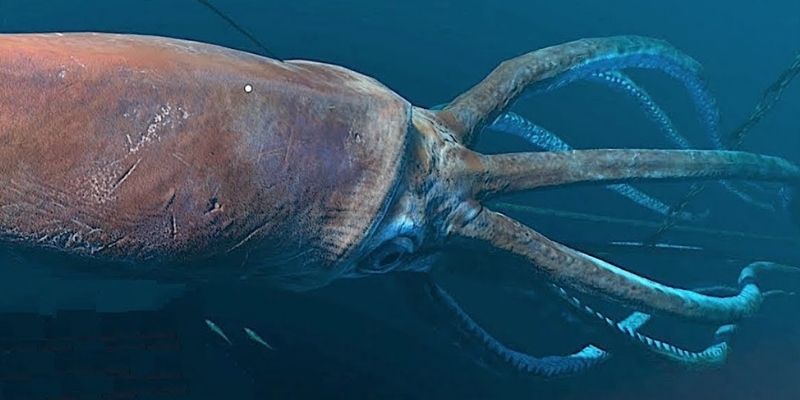
Its existence has been known since antiquity, as the Giant Squid is mentioned both by Aristotle and by the Roman author Pliny the Elder.
Tales of the elusive Giant Squid have been narrated by mariners for centuries. However, it was not until the second half of the 19th century that the Giant Squid was scientifically described and documented.
Up until then, the Giant Squid was part of many cultures’ folklore. The most notorious myth is the one of the Scandinavian Kraken. The Kraken is a gigantic sea monster that terrorized the sailors that attempted to cross the North Atlantic.
The word Kraken itself, which comes from Old Norse and means something unhealthy or twisted, is nowadays used in German to refer to the octopus. References to its size were exaggerated to the point that it was sometimes said to be as big as a floating island and that ships were engulfed in the whirlpool created when the sea monster disappeared back into the ocean.
Even though it is suggested that the myth of the kraken derived from sightings of the Giant Squid, the Kraken is a creature described with various animals’ attributes: earliest descriptions present it as a crab-like creature, and most of the stories refer to an octopus-like monster, sometimes with some whale-like features.
Modern times and modern technology (including less noisy ROVs) brought the end of the myth and the beginning of some real facts about the Giant Squid. The first time scientists managed to record the behavior of Giant Squid in the deep ocean was as recently as 2012. It still looks (and actually is) giant, and somewhat otherworldly but it is surely no floating island, nor so monstrous as a matter of fact.
—Deep Sea Inhabitant—
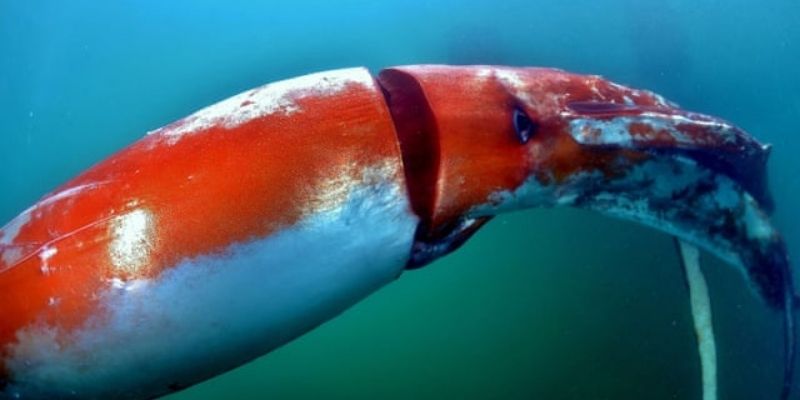
The Giant Squid has long been portrayed as a daunting sea monster, haunting the dreams of seafarers and of human imagination in general.
But there is really no need to stay away from your favorite beach in fear of encountering this enormous creature. Although not much is known about its behavior, most specimens have been collected at a depth range of 300–1,000 meters (980–3,280 ft).
As far as its distribution is concerned, the Giant Squid can be found almost all over the world, but its presence is scarcer in tropical and polar waters.
—What Do Giant Squid Eat?—
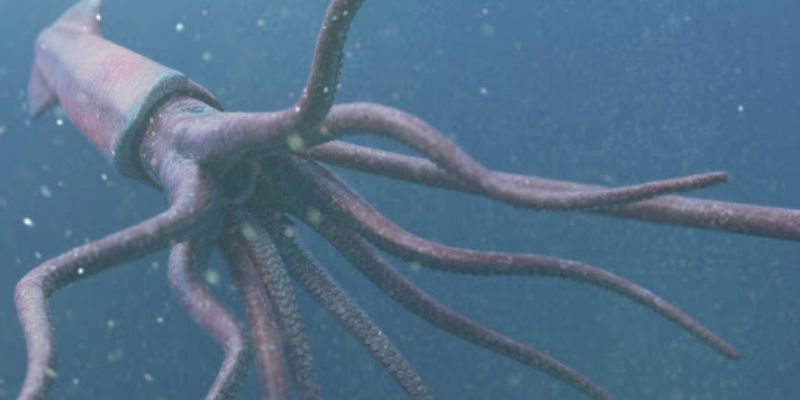
Most importantly, will it eat me?
As sightings of live Giant Squid are rare, most of the information we have about its eating habits comes from the examination of the content of the stomach of dead carcasses. Thankfully, no human parts were ever found so no, the Giant Squid will NOT eat you.
It will, however, feed mostly on shrimp, and other species of squid, and even small whales.
The mouth of a Giant Squid, like the one of the octopus, consists of a sharp parrot-like beak and a tongue-like instrument called the radula, which is covered with rows of tiny teeth. The Giant Squid can attack its victim from a distance of 10 meters (33 feet), grasping it with its two long tentacles which can stretch like elastic bands and are lined with powerful suckers.
Scientists have also collected evidence from dead carcasses that indicate Giant Squids will sometimes fight over available food sources and when these sources are limited, they will even consume other members of their own species. This is not, however, uncommon as cannibalism has also been observed among other cephalopods such as the Humbolt Squid or female octopuses such as the Big Blue Octopus.
Jellyfish are not part of the Giant Squid diet. So, you might be wondering why scientists used electronic jellyfish in order to lure Giant Squid and capture them on video. When jellyfish are under attack, they use their flash to attract even larger predators in hopes of getting away. Giant Squid, therefore, arrive to feed on the jellyfish attackers. Therefore, even though the Giant Squid does not eat them, flashing jellyfish are, in fact, the correct bait to attract this elusive giant.
—Giant Squid Predators—
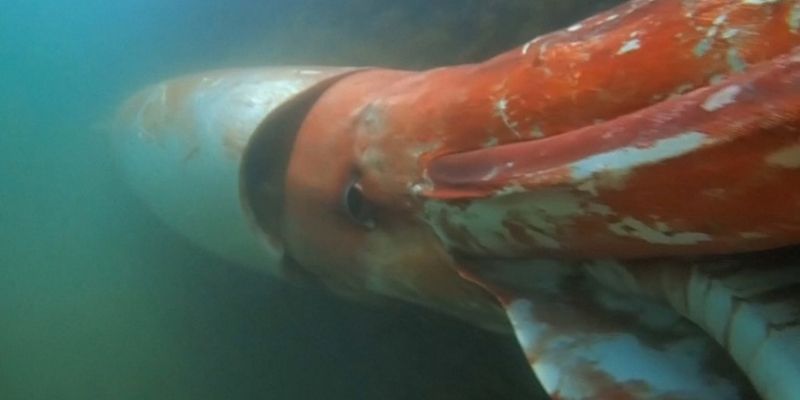
The Giant Squid sits proudly on top of the seafood chain. Very few marine animals are large enough to capture, kill, and feed on the Giant Squid.
The main enemy of the Giant Squid is the enormous sperm whale. Scientists have found Giant Squid beaks inside the stomachs of sperm whales.
The sperm whale uses several mechanisms to trace the Giant Squid, including echolocation (sonar) or stimulating bioluminescence around its mouth to attract the Giant Squid.
But the fight between the sperm whale and the Giant Squid is not completely risk-free: sperm whales have been observed with circular marks on their bodies, battle scars left from the serrated rings around each sucker of the Giant Squid’s arms.
When young and smaller, Giant Squids are faced with more dangers, including other whale species (e.g. pilot whales) or deep-sea sharks and larger fishes.
—Giant Eyes—
It is hard to see in the darkness of the abyss. No wonder why the Giant Squid has developed giant eyes in order to spot any approaching enemy in the darkness.
The eyes of the Giant Squid (together with its close relative, the Colossal Squid (Mesonychoteuthis hamilton) are the largest eyes in the entire animal kingdom! Their size can amount to 10,63 inches! This is as big as a large dinner plate or a basketball!
Now you may ask how can the giant squid see in the complete darkness of the abyss, even if it possesses these ridiculously huge eyes. The answer, in a single word, is bioluminescence.
Bioluminescence is the ability of certain animals to produce light. Many of the abyss’ inhabitants are bioluminescent, including the giant squid’s number one enemy, the sperm whale. The giant squid’s enormous eyes are able to detect bioluminescent organisms from many miles away.
Despite their eyes being gigantic, scientists have discovered that the optic center in the brain of giant squids is actually quite small and simple in comparison to other shallow-water cephalopods. This fact can be easily understood considering that vision is seldom needed in the murkiness of the deep ocean.
Finally, although they are, indeed, giant, the eyes of the Giant Squid are proportionally as big as the eyes of other squid species considering the size of its entire body.
—Lifespan And Reproduction—
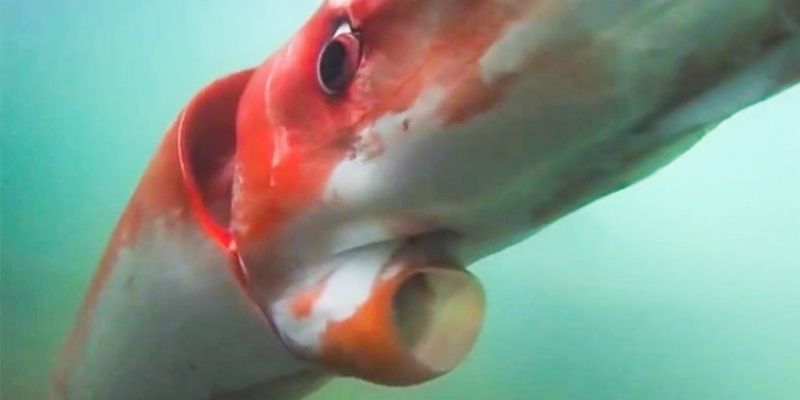
Giant Squid possess an organ called the statocyst which helps them maintain their balance. This statocyst, in turn, contains a mineralised mass known as a statolith. Scientists are able to calculate the approximate age of a squid by counting the growth rings that accumulate on the statolith. Up to now, such measurements suggest that Giant Squid do not live longer than five years.
Squids are sexually dimorphic, meaning that there is a difference in size between males and females: the females are about twice as long as the males! Other than that, not much can be said with certainty regarding their mating habits and reproduction processes.
Most probably, like many other cephalopods, Giant Squids are also senescent, meaning that they only reproduce once in their lifetime. It has been suggested that they use chemical signals to track a mate in the vastness of the deep sea.
Among the theories regarding mating, there are researchers who have even proposed that male Giant Squid might eject their spermatophores from some distance towards the females.












